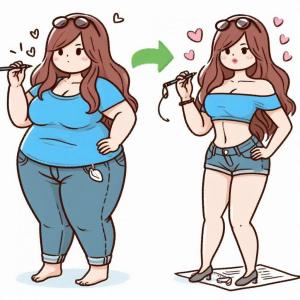
Losing belly fat is a common goal for many people due to health and aesthetic reasons. Excess abdominal fat is associated with an increased risk of heart disease, type 2 diabetes, and other health issues. Here is a comprehensive guide that covers diet, exercise, sleep, and stress management.
1. Diet
a. Reduce Sugar and Sugary Drinks
-
How it helps: Sugar contains fructose, which can accumulate as fat in the abdomen, contributing to belly fat.
-
What to do: Avoid sugary drinks, candies, pastries, and sweet foods.
b. Eat More Protein
-
How it helps: Protein increases satiety, boosts metabolism, and reduces appetite, aiding fat loss.
-
What to do: Include protein-rich foods like eggs, fish, lean meats, nuts, legumes, and dairy products.
c. Include Healthy Fats
-
How it helps: Healthy fats can help with long-term satiety and reduce overall calorie intake.
-
What to do: Consume avocados, nuts, seeds, olive oil, and fatty fish.
d. Limit Refined Carbohydrates
-
How it helps: Refined carbs (like white bread, pasta, and sweets) digest quickly and cause blood sugar spikes, contributing to fat storage.
-
What to do: Opt for whole grains, fruits, and vegetables instead.
e. Increase Fiber Intake
-
How it helps: Fiber aids digestion, reduces calorie absorption, and increases feelings of fullness.
-
What to do: Eat more vegetables, fruits, legumes, and whole-grain products.
f. Monitor Portion Sizes
-
How it helps: Overeating leads to weight gain and fat accumulation.
-
What to do: Be mindful of portion sizes and learn proper food measurement.
2. Exercise
a. Cardio Exercise
-
How it helps: Cardio exercises like running, cycling, or swimming increase calorie burn and help in fat loss.
-
What to do: Aim for at least 150 minutes of moderate or 75 minutes of intense cardio exercise per week.
b. High-Intensity Interval Training (HIIT)
-
How it helps: HIIT involves short, intense exercises followed by rest periods, effective for burning fat.
-
What to do: Do 20-30 minutes of HIIT workouts 2-3 times a week.
c. Strength Training
-
How it helps: Increases muscle mass, which can boost metabolism and aid in fat loss.
-
What to do: Include weight training or bodyweight exercises at least twice a week.
d. Abdominal Exercises
-
How it helps: While abdominal exercises alone won’t eliminate fat, they can help tone the abdominal area.
-
What to do: Incorporate exercises like planks, crunches, and leg raises into your routine.
3. Sleep
a. Importance of Quality Sleep
-
How it helps: Lack of sleep is associated with increased appetite and fat accumulation.
-
What to do: Aim for 7-9 hours of quality sleep each night.
b. Establish a Sleep Routine
-
How it helps: A good sleep schedule supports metabolic health and hormone regulation.
-
What to do: Create a consistent sleep routine and avoid screens before bed.
4. Stress Management
a. Role of Cortisol
-
How it helps: High stress levels increase cortisol, which can lead to belly fat accumulation.
-
What to do: Use stress-reducing techniques like meditation, yoga, deep breathing, or hobbies.
b. Balancing Social Life
-
How it helps: Social support and a balanced life can reduce stress.
-
What to do: Maintain healthy relationships and engage in activities that make you happy.
5. General Tips
a. Be Consistent
-
How it helps: Consistency is key to achieving and maintaining results.
-
What to do: Create a realistic plan and stick to it.
b. Set Realistic Goals
-
How it helps: Realistic goals keep you motivated and focused.
-
What to do: Set small, achievable goals on the way to larger ones.
c. Drink Plenty of Water
-
How it helps: Water aids digestion and enhances feelings of fullness.
-
What to do: Drink at least 2 liters of water daily, more if you are physically active.
Conclusion
Losing belly fat requires a holistic approach that includes a healthy diet, regular exercise, quality sleep, and effective stress management. Consistency and adapting the plan to your specific needs are crucial. With the right approach and persistence, you can achieve your goals and improve your overall health.




















